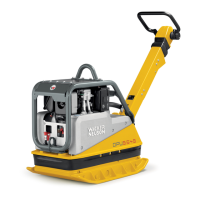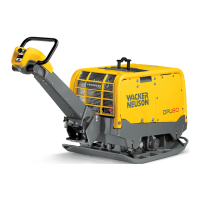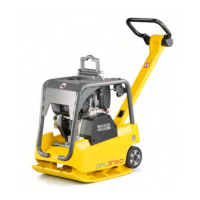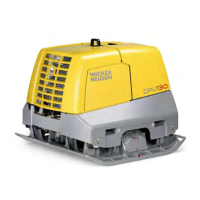T00464GB
11
DESCRIPTION
Description of function
The vibration required for compaction is produced by the exciter (13) which is firmly joined to the lower mass
(5). This exciter (13) is designed as a central vibrator with aligned vibrations. Such a principle permits the di-
rection of vibration to be changed by turning the eccentric weights (15). In this way an infinitely variable transi-
tion between vibration in forward motion (Fig. 1), at standstill (Fig. 2) and in reverse motion (Fig. 3) is possible.
This process is hydraulically controlled with the operating control handle (6) on the centre pole head (7).
Forwards Standstill Reverse
The drive engine (1) anchored to the upper mass (4) drives the exciter (13). The torque is transmitted by means
of a friction connection through the centrifugal clutch (11) and the exciter V-belt (12).
The centrifugal clutch (11) interrupts flow of power to the exciter (13) at low engine speed and thus permits
perfect idling of the drive engine (1).
The automatic V-belt pulley (10) combined with the centrifugal clutch (11) ensures optimum tension of the ex-
citer V-belt (12) during operation and relief of the tension of the exciter V-belt (12) when the machine is being
relocated or transported.
Moreover, the automatic V-belt pulley (10) automatically adapts to the V-belt flanks in line with the wear and
thus makes the entire drive from the engine (1) to the exciter (13) maintenance-free.
The speed of the drive engine (1) can be infinitely varied by remote control on the throttle control lever (8).
The upper (4) and lower (5) masses are connected to each other by 4 vibration-damping rubber metal shock
mounts (14). This damping system prevents the very high frequencies from being transmitted to the upper
mass (4). As a result the functionability of the drive engine (1) is retained in spite of the high compaction per-
formance.
The drive engine (1) works on the diesel principle; it is started electrically by a pinion starter (3), draws in the
combustion air through an air filter, dry (9) and is air-colled.
To facilitate the starting procedure (at very low temperatures, with hand start) the drive engine (1) has an au-
tomatic decompression mechanism (2). It ensures that compression is very low during the cranking operation
but steadily increases after a few revolutions when it then switches over to full compression.
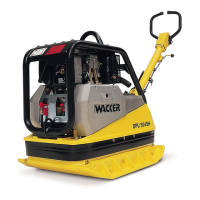
